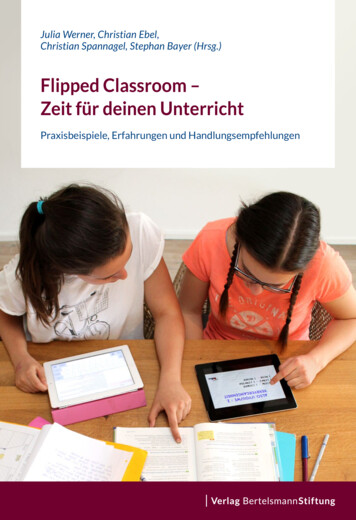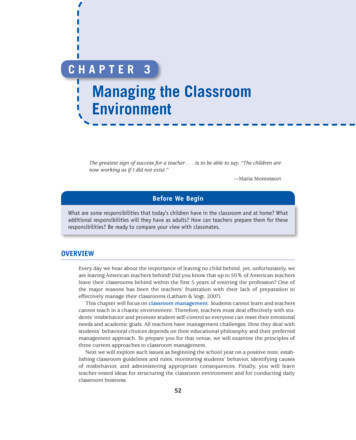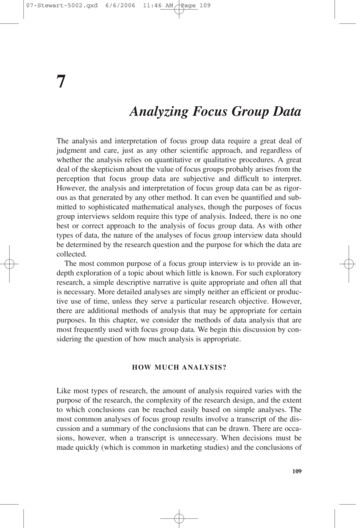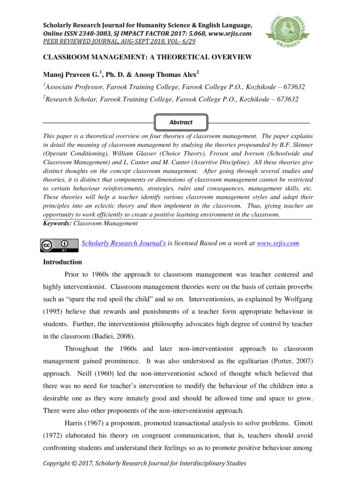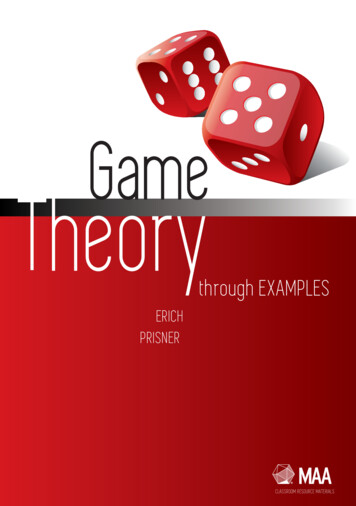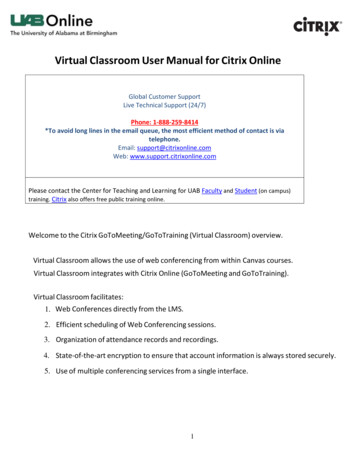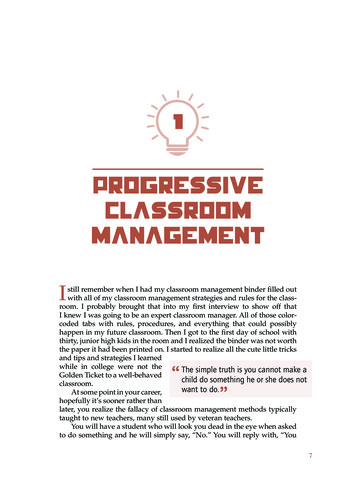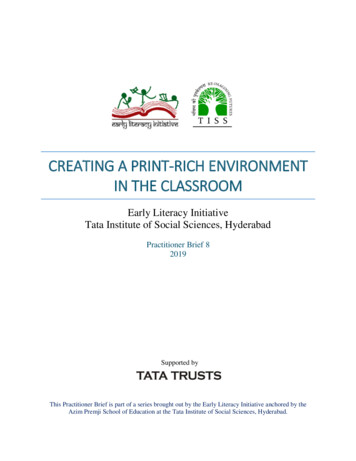
Transcription
FOCUS ON THE CLASSROOM/PLEINS FEUX SUR LA CLASSECross-Cultural Awareness forSecond/Foreign Language LearnersElizabeth M. KnutsonAbstract: This article proposes a reconsideration of curricularobjectives with respect to the teaching of culture, in the interest of broadeningthe humanistic scope of the second/foreign language curriculum while at thesame time alleviating the pressure of a typically over-extended instructionalagenda. Recent research and theory support a relational approach to culturelearning, emphasizing understanding of the target and home culture(s) asthey relate to one another, with explicit reference to the learner's culturallysubjective position. The article explores the notions of cultural identity andattitudes toward the other, arguing for increased emphasis on an understanding of self as cultural subject and openness of mind toward culturaldifference. Topics and activities for a curricular module on cross-culturalawareness are suggested.Resume : Cet article propose une reevaluation des objectifs scolairesen matiere d'enseignement de la culture, dans le but d'elargir la perspectivedes programmes de langue seconde et de langue etrangere en matiere desciences humaines, tout en reduisant la pression decoulant d'un programmeeducatif que Ton tend a etirer. Des theories et des recherches recentessoutiennent qu'il est necessaire d'adopter ime approche relationnelle dansl'enseignement de la culture, en mettant l'accent sur la n cessite de comprendre sa propre culture et celle de l'autre ainsi que la maniere dont ellesinteragissent, en faisant clairement reference a la position subjective del'apprenant par rapport a sa culture. Cet article aborde les notions d'identiteculturelle et les attitudes envers autrui; on y souligne l'importance croissantea accorder a la comprehension de soi a titre d'objet culturel ainsi qu'al'ouverture d'esprit envers les differences culturelles. Des themes et desacdvites sont proposes dans le cadre d'un module d'apprentissage portantsur la conscientisadon interculturelle. 2006 The Canadian Modern Language Reviewflji Revue canadienne des langues vivantes,62,4 gune/juin), 591-610
592Knutson'L'etrange est en moi, done nous sommes tous des etrangers. Sije suisetranger, il n'y a pas d'etrangers.'-Julia Kristeva (1988), Strangers a nous-memesThe integration of culture into the second/foreign language curriculumhas progressed rapidly in recent years. Standards of cultural competenceand goals for culture learning are currently an integral part of instructional programs at all levels, and French textbooks are replete w ithcultural material pertaining to the French-speaking world. Because thestandards and goals for language learning have throughout this timeremained relatively unchanged, the overall mission of language teachinghas, in effect, expanded, and 'doing it all' -developing languageproficiency in four skills and introducing students to a broad range ofcultural material, all the while keeping LI use in classroom interactionto a minimum -has become the unspoken imperative. This articleproposes a reconsideration of curricular objectives with respect to theteaching of culture, in the interests of broadening the humanistic scopeof the language curriculum while at the same time alleviating thepressure of a typically over-extended instructional agenda. Whilethe article focuses specifically on French and francophone cultures, thearguments put forward and the approaches suggested are equallyapplicable to other second or foreign language contexts.Traditional 'culture as information' approaches are problematic, notonly because they present the difficult choice of which culture(s) to teachand what content to include but also because they implicitly representcultures under study as other, or marked, diverging from the homeculture norm. By contrast, instruction geared toward the developmentof cross-cultural awareness and understanding of the concept of culturebound values and behaviour acknowledges the relational nature ofcultural study. Inter-cultural learning, based on the principle thatstudents cannot learn about values of another culture (C2) withoutconsidering those of their own (Cl), requires relinquishing coverage ofcontent {information about Cl) in favour of a less tangible culture agendathat Galloway (1999) has aptly termed 'growing the cross-cultural mind'(p. 153). This broader objective is particularly important, yet oftenoverlooked, in the early stages of language study, and particularly inrequired courses, when many learners may be motivated by somethingless than an affiruty for a second or foreign culture.Learner attitudes toward a second or foreign cultureA classroom interaction several years ago led me to reflect upon therelationship between a learner's cultural identity and his or her attitudes 2006 The Canadian Modern language Review/La Revue canadienne des Iangues vivantes,62,4 (June/juin)
Cross-Cultural Awareness for L2/FL Learners593toward cultural difference and to rethink the implicit culture agendagoverrung my own teaching. During an oral exercise, a student hadoccasion to utter the exclamation 'Ooo la la !' By way of response, Ilaughed and added, 'Mais en France, on dit "Oh la la !'" -to which heunhesitatingly replied, in English, 'But I'm an American!' I was struckby the contrast between my student's attitudes toward cultural identityand my own, for as a student I had always aspired to be like the other,and as an instructor I wanted to present my students with nativespeaker models of language. My student, by contrast, was clearly notinterested in sounding or acting French. Instead, he asserted hisAmerican identity and gave voice to it through the speaking of French,a reaction that seemed to me, at the time, to reflect a certain resistanceto language and culture learning.In her analysis of the learner's cultural third place -the spacebetween home and target cultures -Kramsch (1993) has alluded to theperennial struggle between the instructor, who seeks to foster understanding and appreciation of C2 behaviours and values, and thelearners, who use cultural knowledge for their own purposes and 'insiston making their own meanings and [.].relevances' (p. 239). Theinteresting and sometimes challenging case of students whose impulseis not to identify with or become like the cultural other raises the issueof identity and authenticity and points to the need to acknowledgelearners as cultural subjects, and raise their awareness of self as such,before moving on to culture learning in the more traditional sense ofstudying aspects of daily life, social practices, or institutions.As language instructors are well aware, learners' attitudes toward asecond or foreign culture may range from fear, hostility, and resistance,on one end of the spectrum, to attraction or even unquestioningfascination, on the other. Just as we may have the pleasure of teachingstudents who are motivated by the appeal and excitement of differenceand who, as a result of classroom study or experience abroad, evenadopt 'an altered cultural personality and identity' (Damen, 1987, p.142), so, too, we may grapple with the problem of students whovigorously embrace long-standing negative stereotypes and images ofa second or foreign culture. But whether students display affinity orresistance, their awareness and understanding of the nature of culturalidentity and difference as such may be rudimentary or non-existent.In addition, beyond the classic categories of motivation relating to thelearner's affinity for the target culture community (integrative) or longterm utilitarian purposes (instrumental), it is reasonable to expect thatmotivation in culture learning and receptivity to a culture and itsspeakers will vary according to situation (e.g., classroom or community) 2006 The Canadian Modem Language Review/La Revue canadienne des langues vivantes,62,4 Oune/juin)
594Kjiutsor\and conununicative context (to w hom one is speaking, and for whatpurpose). Students can find themselves in any number of differentlearning situations -interacting with an instructor individually or inclass, writing a composition, performing a skit in front of classmates, orasking questions of a native speaker in a classroom interview -each ofwhich could call forth different attitudes and behaviour with respect tothe second/foreign culture or culture-bearer. Furthermore, socialfactors, including issues of 'face' -not wanting to be seen as overlyinvolved, too smart, or trying too hard in front of peers -may affectstudents' attitudes or behaviour toward language and culture as theyare displayed during classroom interaction. In this sense, motivationand what might be called cultural stance or disposition are not fixed, oreven stable, phenomena.Being our (cultural) selves in the classroomWhile many L2 and FL instructors are likely motivated by an inherentinterest in dissimilar others, students' dispositions toward the C2 and itsspeakers may be more circumspect. Students may adopt or try onfeatures of the language or culture -words, phrases, signs, or behaviours -for a variety of social purposes, including humour and play.Should this kind of hybridization (a cultural analogue oifranglais) beviewed as problematic? Analyzing the concept of authentic language inthe language classroom, Widdowson (1998) writes that commimicativeapproaches to language instruction must 'come to terms with thelearners' reality and somehow create contextual conditions that areappropriate to them and that will enable them to authenticate it asdiscourse on their own terms' (p. 712). Similarly, culture learning ismost legitimately considered authentic when the reality of learners'cultural identities and the mixed messages and feelings that are apt toemerge when studying other cultures are acknowledged in theclassroom rather than displaced or repressed. As Briere (1986) hassuggested, the goal in culture teaching is to foster understanding, notnecessarily love or affiliation. A student's antagonistic attitude towarda particular cultural community may even fossilize if vigorouslycountered by the instructor. Ethnocentrism is therefore best viewed nonjudgementally, as a starting position in culture learning rather than afixed learner attribute (Bermett, Bennett, & Allen, 2003).In recent years the long-standing norm of the educated nativespeaker, against which learners' language proficiency is measured inboth govemment and academic proficiency testing, has been called intoquestion. Kramsch (1997), for example, argues that the native speaker 2006 The Canadian Modem Language Review/La Revue canadienne des langues vivantes,62,4 (June/juin)
Cross-Cultural Awareness for L2/FL Learners595in terms of both linguistic authority and social and cultural authenticity -is an imaginary construct and consequently suggests a 'rethinkingof the subject position' of language learners (p. 360). In her analyses ofthe pleasures and privileges of being 'in between/ the learner positionis conceptualized not as a deficiency but as an inherently interestingvantage point and place to be. Galloway, for her part, highlights thedimensions of conflict and multiplicity within the learner's own culturaland subcultural identities and in cross-cultural encounters (1999, p. 164).And the instructor's cultural position is certainly no less complex. ThusMurti (2002), a South Asian professor of German, underscores theunique advantages of the non-native instructor, who, in her words, iswell situated to 'teach people from other cultures how to use somebodyelse's linguistic code in somebody else's cultural context' (p. 29).According to these analyses, conflict, exhilaration, and even ambivalenceare equally strong signs of life in the inter-cultural learning process.Instructors and students alike occupy multiple subject positions, and theL2 or FL classroom can therefore be conceptualized as a place of culturalintersection, a context in which to learn about Canadian, French, orother cultural and subcultural identities. Relevant questions in this kindof culture learning are relational rather than absolute (Briere, 1986);studying another people's values and practices tells us something aboutour own. Framing the question as relational rather than objective is animportant step toward what Briere has called perceiving the other 'as acultural subject rather than a cultural object' (p. 204) and also towardunderstanding oneself as culturally determined. Thus, questions suchas, 'What similarities and differences between the first and secondculture can we see?' 'What is particularly appealing or unappealing tous, and why?' 'What is unexpected or difficult to understand?' and,especially, 'What might others find strange about our ways of speakingor thinking?' remind learners of the relational nature of culturalobservation. The ongoing process of identifying and understandingsimilarities, differences, affinities, and disaffections is a feature of criticalpedagogy that allows for a mix of cultures -and for an honest, intelligent accounting of mixed feelings as well. Culture learning goals: Which culture(s) to teach?Culture-specific content includes knowledge about societal values,practices, and products. These goals relate to the recogrution andcomprehension of distinctive cultural viewpoints on various issues andpatterns of behaviour and interaction, as well as to familiarization withcultural products of many kinds, ranging from implements of daily life 2006 The Canadian Modern Language Review/La Revue canadienne des langues vivantes,62,4 0une/juin)
596Knutsonto paintings or literature. Culture-specific content includes features ofhigh and low culture commonly found in textbook material, such aspractical aspects of daily life, and civilization topics such as social andpolitical institutions, economic trends, or the arts.As Fantini (1999) has suggested, the heterogeneity of low-contextcultures (those that exhibit more and greater differences among groupsand individuals) 'raises questions about what cultural aspects to teachwithout overgeneralizing' (p. 186). This has always been the case -forall instructional materials and programs inevitably reflect conscious orunconscious choices about the social situations and participants to berepresented and described -but the question of what exactly constitutesthe C2 or the target culture(s) is even more striking in the face of theexpanded focus on the francophone world, the multicultural Canadiancontext, and changing demographics within France. It is also difficult forinstructors to acquire famiharity with, let alone expertise in, the widerange of regions and cultural topics typically included in textbookmaterial. In many cases instructors may not have first-hand experiencewith one or more of the target cultures, or, if they do, it may not berecent or in depth (Damen, 1987, p. 56; Allen, 2000, p. 52).Within Canada, the cultural hetereogeneity of Montreal and theprovince of Quebec is increasingly complex, and for the francophonepopulation outside of Quebec the relative importance of language andregional affiliation to cultural identity is a pertinent question. Inaddition, as LeBlanc and Courtel have indicated, French Canadianculture can be defined as a 'culture of situation,' meaning that culturalidentity is tied to the situation of being a 'linguistic and culturalminority, at once threatened and seduced by assimilative forces,' morethan to particular behaviours, beliefs, or customs (1990, p. 83). Sensitization to the deeper social/political dimension of cultural identity is ofparticular importance for the Canadian context, and for countries likeSwitzerland and Belgium as well.In France, the relative homogeneity of the past has given way tomuch greater ethnic diversity as a result of economic migration. Inaddition, distance and, to some extent, dissimilarity have diminished inrecent years, given the globalization of cultural trends and the extraordinary accessibility of news, film, and music. Although cultural differencehas not evaporated, and the negotiation of social interaction still calls forskill and understanding, it is safe to say that North American studentstoday recognize more of their own world on the other side of theAtlantic. And while Furope arguably does not represent a culture assuch, many transnational institutions and structures are now a familiarpart of French political and economic life. 2006 The Canadian Modern Language Review/La Revue canadienne des langues vivantes,62,4 (June/juin)
Cross-Cultural Awareness for L2/FL Learners597The notion of hybrid cultural space more aptly describes today'sworld, as suggested in a 2002 issue of PMLA devoted to the theme ofmobile citizens, media states, and the relative meaninglessness of placein a global economy. Heterogeneity and multiplicity of cultures are quitesimply the hallmark of contemporary life, and cultural identity withinnations is marked by increased fluidity and complexity (Rodowick, 2002,p. 16). Artists themselves are often products of mixed cultural heritageand reflect that diversity in their work. Thus, for example, singersHelene and Celia Faussart of Les Nubians, born to a French father andCameroonian mother and raised in both France and Chad, assert theirafropeanite, a cultural identity stemming from colonization and migrationthat they see as newly formed, 'en construction' (Dicale, 2003, p. 15). Themixing of languages (French, English, Creole, Spanish) in the rap musicof Quebec's hip-hop community is another striking example of thehybridization of cultural and linguistic identity that marks contemporary urban life (Sarkar, Winer, & Low, 2005).Given the phenomena of global interdependence and increasingcultural diversity within national boundaries, comprehensiveness incurricular content is impossible and coherence elusive. Accordingly,instructors and program developers must make decisions about whatcontent areas to select, based on some mix of factors including students'need or desire to know, curricular guidelines, and instructors' expertiseand/or areas of interest. In the larger picture, however, the need forselectivity is not cause for lament. Acknowledging that we cannot graspculture in its entirety is an exercise in realism and humility. As Damen(1987) has suggested, all cultures are in process: 'Cultures and culturalpatterns change. It is more important to learn how to learn a culture oradapt to these changes than to learn the 'facts" and 'truths" of themoment' (p. 88). Reducing coverage of cultural content makes space forconsideration of important culture-general issues, such as the need forempathy with others, and for understanding the nature of culture (pp.262-263) and its internal conflicts. A greater focus on the nature ofcultural identity, with examples from both home and target cultures,allows students to appreciate the cultural heterogeneity that defines selfand other at any given moment and over time.'*The culture-general goal of cross-cultural awarenessCulture-general curricular objectives include fostering dispositionalattributes such as tolerance of and respect for cultural difference orinterest in the unfamiliar. In addition, one of the most basic andimportant goals of intercultural education, many educators and 2006 The Canadian Modem Language Review/La Revue canadienne des tangues vivantes,62,4 (June/juin)
598Knutsonresearchers agree, is to lead students to some understanding of thenotion of culturally determined behaviour as such (Fantini, 1999, pp.167,184485; Kramsch, 1983, p. 438; Manfle-Bromley, 1992, p. 119), sothat they begin to see themselves, not just others, as culturally marked.In Byram's terms, this amounts to an understanding of the relativizationof self (1997, p. 22); thus, Byram's seminal defirution of the inter-culturalspeaker includes recognition of self and other as socially constructed(Roberts, Byram, Barro, Jordan, & Street, 2001, p. 30). Decades ago. Hall(1959) suggested that the primary goal of language and culture study 'isnot to understand foreign culture, but to understand our own' (p. 53).And, as Damen (1987) has argued, awareness of self is a necessarycorollary to awareness of others:Cross-cultural awareness involves uncovering and understanding one'sown culturally conditioned behavior and thinking, as well as the patternsof others. Thus, the process involves not only perceiving the similaritiesand differences in other cultures but also recognizing the givens of thenative culture, (p. 141)In a similar vein, Briere (1986) argues for an approach that acknowledges the relative nature of any discourse on a second or foreign cultureand defines the observer's position as subjective rather than neutral orabsolute.The goal of understanding self and other as culturally constructedfeatures in both the culture syllabus of the National Core French Study(NCFS) in Canada and the American Coimcil on the Teaching of ForeignLanguages (ACTFL) National Standards. Among the general objectivesof culture learning cited in the NCFS is the broadening of students'cultural horizons, defined as openness to cultural difference and alteredawareness of one's own culture (LeBlanc & Courtel, 1990, p. 86).Similarly, one of the ACTFL Standards stipulates that students 'recognize that cultures use different patterns of interaction and can apply thisknowledge to their own culture' (National Standards, 1996, p. 216);students reaching this objective are said to understand their homeculture as distinct and to develop some iinderstanding of the concept ofcultural specificity and cultural systems, continually discovering'perspectives, practices, and products that are similar and different fromtheir own culture' (p. 216).In addition to identifying the learner's position as a cultural subject,the development of cross-cultural awareness requires recognizing theinternal diversity and conflict that typically characterize the homeculture (Galloway, 1999, p. 164). Instructors and learners alike, as 2006 The Canadian Modem Language Review/La Revue canadienne des langues vivantes,62,4 (June/juin)
Cross-Cultural Awareness for L2/FL Learners599cultural subjects, are constantly in process; we belong to subculturesdefined by ethnicity, gender, geography, generation, and other factors.Coming to terms with cultural others requires recognizing others within-on a personal level but also as a multicultural society. The purpose ofdeveloping awareness of self as a cultural subject in classroom study isthus to increase students' understanding of the nature of culturalidentity, with its conflicts and multiple dimensions, to make culturalpractices in their own environment visible to them (Crawford &McLaren, 2003, p. 146), and to preclude simplistic reactions to differenceand overgeneralization about regional or national culture(s). Whereascross-cultural training is focused on developing an individual's practicalability to function in a second or foreign culture, the understanding ofself as culturally determined is closely associated with the humanisticvalues L2 education is designed to promote, and it is a valuable asset forlifelong learning as well. Individuals may eventually forget particularsof their knowledge about a culture (and particulars change in any case)but keep in mind more general notions about approaches to culturelearning, categories of cultural behaviour, or the nature of languageculture relationships.Given the wide range of motivations and dispositions commonlyfound among intermediate-level students, careful consideration of goalsfor culture learning is paramount. An analysis of learners' real worldand academic needs, in terms of cultural knowledge, awareness, orability to function in culturally appropriate ways, is a first step. Withwhom will students be interacting, and in what contexts? For manylearners of French, the second culture is close at hand. Qthers may travelto France, Morocco, or another Francophone country and conununicatewith educated native speakers, or use French as a lingua franca to speakwith foreigners they meet abroad. Still others may never have occasionto interact with French speakers of any kind, and the cultural component in language coursework must be meaningful for those students aswell. A second/foreign language curriculum driven by humanisticobjectives as well as practical ones would place greater emphasis oncross-cultural awareness than is commonly the case, while maintaininga limited, carefully selected share of culture-specific content, dependingupon students' interests and needs and instructors' expertise.While many instructors and curriculum developers might agree inprinciple that cultural self-awareness is a valuable goal, academicprograms in which it figures prominently are perhaps not so easilyfound, particularly at lower levels or in required courses. Work of thisnature may be seen as moving beyond the domain of language andculture teaching into that of anthropology. However, when the self 2006 The Canadian Modern Language Review/La Revue canadienne des langues vivantes,62, 4 (June/juin)
600Knutsonawareness component of culture learning is missing, a skewed perspective on second or foreign cultures may emerge. The following suggestions for a cross-cultural awareness module are offered in the interestsof strengthening this dimension in the early stages of language learning.A curricular module on cross-cultural awarenessIf time permits, or if traditional content coverage can be reduced,intermediate-level secondary or uruversity courses might begin with aone- or two-week unit on cultural awareness, taught in both LI and L2.While unorthodox, a curricular unit of this kind, with activities designedto encourage reflection on cultural behaviour in the home environmentand the concept of culture-specific behaviour itself, would unarguablyprovide students with an extremely valuable perspective on the culturaldimension of communication and language learning. The module issuggested for the intermediate rather than the introductory level, toensure that learners have had enough contact with the L2 or FL toformulate their own questions about cultural similarities and differencesand have acquired sufficient reading proficiency to work with selectedL2 texts.A questiormaire designed to elicit learners' attitudes or questionsabout cultural issues can be administered at the outset, and students canbe invited to reflect on these issues in writing again at a later stage.Regular journal entries, written entirely or partly in the LI, are anothervehicle for encouraging open-ended thirJcing about cultural questions.In addition, instructors and their colleagues can talk with students abouttheir own personal history of intercultural learning experiences andevolving attitudes toward different cultural groups.Possible topics for the cultural awareness unit include (but are notlimited to) defining the self as cultural subject; subcultures within thehome culture; insider views of the second/foreign culture; outsiderviews of the home culture; culture-speciflc language behaviour; andcross-cultural misimderstandings. The activities described below can beselected a la carte, according to the needs of particular students andprograms. If an extended, 'stand-alone' unit is not feasible, a smallerselection of activities can be integrated at regular intervals into thecourse syllabus.Self as cultural subjectAt the outset, students are invited to reflect upon the cultural dimensionof their own identity. The instructors can model this process by sharinga short list of attributes, values, or behaviours descriptive of herself that 2006 The Canadian Modern Language Review/La Revue canadienne des langues vivantes,62,4 (June/juin)
Cross-Cultural Awareness for L2/FL Learners601she considers to be culturally determined rather than personal. Studentswrite their own lists, then compare them with those of classmates as aprelude to whole-group discussion. Alternatively, in an activity outlinedby Paige, Cohen, Kappler, Chi, and Lassegard (2002a), students definethemselves as cultural subjects by naming various aspects of theiridentity (only child, city-dweller, athlete, etc.) in a series of seven oreight different circles that constitutes a 'personal culture diagram.'* Theythen choose one or two identities that seem more important than theothers and, in a later stage, associate values with each of the circles. Theactivity is a vehicle for discussion of multiple influences within one'sown life and, as such, is designed to pre-empt reductionistic characterizations of the cultural identity of others.Subcultures within the home cultureStudents are led to consider the nature of subcultural differences oraffinities related to age, gender, race, ethnicity, class, or regions in thehome culture. A relevant awareness activity suggested by Fennes andHapgood (1997, p. 203) is the 'piece of culture' exercise, in which astudent presents an object that is meaningful to a particular (sub)culturalgroup, or to him/herself as a member of that group. Students andinstructor can also share personal experiences that relate to regional orethnic identity. The goal of these activities is to raise awareness of selfas culturally defined.Insider views of the second/foreign cultureEthnographic interviews of native speakers offer a view from inside, adescription of a culture in its own terms (Damen, 1987, pp. 59-60), andallow for the discovery of cultural similarities and shared values as wellas differences. Studies investigating the factors that influence anindividual's response to dissimilarity have demonstrated that engagingin interaction increases attraction to dissimilar others (Broome, 1983, pp.146448). Ethnographic approaches reflect this principle and have theadded benefit of allowing instructors to learn along with students,relieving them of the role of expert in the culture learning process. Theinterviewer asks
Second/Foreign Language Learners Elizabeth M. Knutson Abstract: This article proposes a reconsideration of curricular objectives with respect to the teaching of culture, in the interest of broadening the humanistic scope of the second/foreign language curriculum while at the same time
